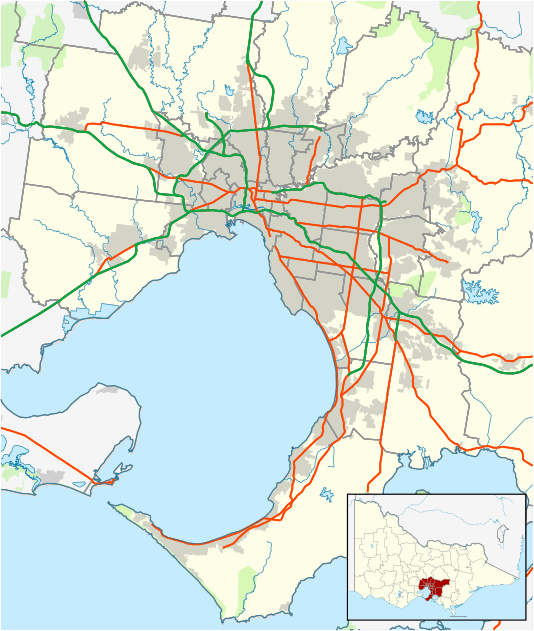Highett, Victoria
| Highett Melbourne, Victoria | |||||||||||||
|---|---|---|---|---|---|---|---|---|---|---|---|---|---|
 Highett | |||||||||||||
| Coordinates | 37°57′S 145°03′E / 37.95°S 145.05°ECoordinates: 37°57′S 145°03′E / 37.95°S 145.05°E | ||||||||||||
| Population | 10,263 (2011 census)[1] | ||||||||||||
| • Density | 2,630/km2 (6,820/sq mi) | ||||||||||||
| Postcode(s) | 3190 | ||||||||||||
| Area | 3.9 km2 (1.5 sq mi) | ||||||||||||
| Location | 16 km (10 mi) from Melbourne | ||||||||||||
| LGA(s) | |||||||||||||
| State electorate(s) | Sandringham | ||||||||||||
| Federal Division(s) | |||||||||||||
| |||||||||||||
Highett is a suburb in Melbourne, Victoria, Australia, 16 km south-east of Melbourne's central business district and 2 km east of Port Phillip. Its local government area is the City of Bayside and the City of Kingston.[2] At the 2011 Census, Highett had a population of 10,263. Highett is bordered by Hampton/Sandringham to the west, Hampton East/Moorabbin to the north and Cheltenham to the east and south.
History
The name comes from William Highett, a parliamentarian and local land owner in the 1850s.[3] The Highett railway station was built when the line from Caulfield to Mordialloc was opened in 1881. Little development happened after the arrival of the railway; the Highett Post Office did not open until 17 November 1924.[4]
The Highett Hall was opened on 11 September 1926 and was used for dances, balls, vaudeville performances and later as a cinema. However it always struggled to find a profitable means to continue operation. It was purchased by the Moorabbin City Council in 1966 and then demolished to make way for the Highett library, which opened on 1 August 1969.[5]
In 1927 a number of Anglicans banded together to open St Stephens Church of England, in Donald Street, Highett.[6] This was the first church built for the local inhabitants of Highett and by 1937 there was also a Catholic church.[7]
In 1939 the Commonwealth Aircraft Corporation (CAC) constructed a factory in Highett to build aircraft wings and fuselages to support Australia in the Second World War. The factory continued operation until the end of the war in 1945 when the tradesmen were transferred to the main CAC factory in Fishermans Bend and the Bay Road site was closed.[8]
Highett's most substantial residential growth began in the 1950s. Industry was attracted to the area, including a large CSIRO research facility. A primary school was opened in 1953 and a high school in 1956, although Highett High School is now part of Sandringham College. The strip shopping centre near the railway line expanded, and still remains active. The suburb is undergoing substantial change and rejuvenation with a high number of residential properties being renovated or redeveloped due to the suburb's proximity to Melbourne City and Port Phillip Bay which has attracted a large number of younger families and professionals. In 2011 construction of a substantial new shopping centre and apartment complex began on Highett Road, using land once owned by the CSIRO.[9]
Noteworthy incidents in Highett
In 1925 a parcel train hit a car at the Wickham Road railway crossing, killing nine people inside the car. The gatekeeper was found not guilty of the charge of manslaughter, the jury finding the incident was due to the fault of the system and not through human negligence.[10]
Sporting clubs and facilities in Highett
Highett Cricket Club
Established in 1887, Highett Cricket Club is the second oldest in Kingston City. The Turner Road complex features three ovals, a large clubrooms and a children's playground. The Bulldogs have a long and proud cricketing history, having three times won the Victorian Turf Cricket Association (VTCA) first division premiership.
In season 2016/17 the club joined the newly created cricket association to be known as Cricket Southern Bayside. Highett 1stXI will be playing in Division 2. In all one day matches Highett players will don the coloured clothing of red white and blue for the first time. Three Highett players have represented Australia in Test cricket: Dav Whatmore, Michael Taylor and Simon Davis. The club has three senior teams, and junior teams from under-12 to under-16. Teams play in the Cricket Bayside and the SECA Formally known as the CMCA.
Public swimming pool
The City of Moorabbin built an Olympic-length swimming pool on Turner Road in Highett in 1964.[11] In the 1990s the pool was extensively refurbished and is now called the Waves Leisure Centre.
Highett Football Club
The suburb has an Australian rules football team, the Highett Bulldogs, which competes in the Southern Football Netball League (SFNL).[12]
The club house is situated on the Main Oval of Highett Reserve, which is on Turner Road. Its senior teams participate in SFNL Division 2, and the junior sides participate in the South Metro Junior Football League (SMJFL).
References
- ↑ Australian Bureau of Statistics (31 October 2012). "Highett (State Suburb)". 2011 Census QuickStats. Retrieved 2012-06-21.
- ↑ http://profile.id.com.au/Default.aspx?id=135&pg=101&gid=220&type=enum
- ↑ Hone, J. Ann. "Highett, William (1807–1880)". Australian Dictionary of Biography. Canberra: Australian National University. Retrieved 17 July 2014.
- ↑ Premier Postal History, Post Office List, retrieved 2008-04-11
- ↑ Whitehead, Graham. "Highett Hall". City of Kingston.
- ↑ Sheehy, Tom (1985). Battlers Tamed a Sandbelt. Moorabbin: City of Moorabbin. p. 54.
- ↑ Sheehy, Tom (1985). Battlers Tamed a Sandbelt. Moorabbin: City of Moorabbin. p. 55.
- ↑ Sheehy, Tom (1985). Battlers Tamed a Sandbelt. Moorabbin: City of Moorabbin. pp. 55, 76.
- ↑ Woolies to anchor shopping centre, apartments, Sydney Morning Herald, 2011-09-14, retrieved 2011-12-29
- ↑ The Highett Railway Disaster, www.brightoncemetery.com, retrieved 2008-05-11
- ↑ Sheehy, Tom (1985). Battlers Tamed a Sandbelt. Moorabbin: City of Moorabbin. p. 159.
- ↑ Full Point Footy, Southern Football Netball League, retrieved 2008-10-21